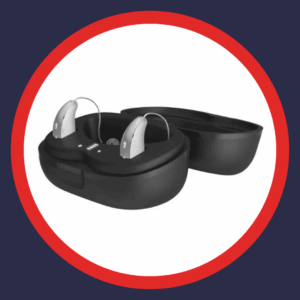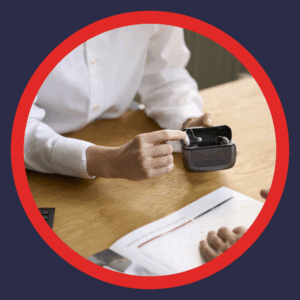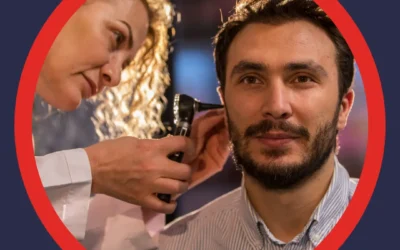Rechargeable hearing aids have transformed the daily experience of hearing care. No more fumbling with tiny batteries every few days. No more wondering if you have spare batteries when traveling. Modern rechargeable hearing aids use advanced lithium-ion technology that powers your devices all day with simple overnight charging.
This shift represents more than convenience. Rechargeable hearing aids deliver consistent sound quality, reduce environmental waste, and eliminate safety concerns around small batteries. For people with dexterity challenges, vision difficulties, or active lifestyles, rechargeable options provide freedom and reliability.
Understanding how rechargeable hearing aids work helps you make informed decisions. This guide explores the benefits, technology, maintenance, and leading models available today.
Why People Choose Rechargeable Hearing Aids
The advantages of rechargeable hearing aids extend across practical, environmental, and performance benefits. Users consistently report higher satisfaction compared to disposable battery systems.
Daily Convenience That Makes Life Easier
Simple overnight charging eliminates battery replacement completely. You place your hearing aids in their charging case each night. Wake up to fully powered devices ready for the day. The routine becomes as automatic as charging your smartphone.
No emergency battery runs mean less stress and planning. Disposable batteries run out at inconvenient times. Rechargeable hearing aids give you predictable, reliable power. Most models include low battery warnings through smartphone apps.
Travel becomes simpler without packing spare batteries. Portable charging cases provide multiple recharges on the go. You need only one small charging unit for trips.
Better for Your Hands and Eyes
Rechargeable hearing aids benefit people with arthritis, tremors, or vision challenges significantly. Tiny disposable batteries require precise handling and small battery door manipulation. Many users struggle with these tasks.
Sealed rechargeable hearing aids eliminate this frustration entirely. You simply drop devices into charging slots. No small parts to align or replace. No worrying about dropping tiny batteries.
Consistent Performance Throughout the Day
Disposable batteries gradually lose voltage as they drain. This causes subtle declines in sound quality and processing power. You may not notice immediately, but performance degrades.
Lithium-ion rechargeable hearing aids maintain consistent power output throughout their charge cycle. Sound quality remains optimal from morning until evening. Advanced features like Bluetooth streaming and AI processing receive steady power.
Environmental Responsibility
Disposable hearing aid batteries create significant waste. Americans discard hundreds of millions of button batteries annually. These end up in landfills where toxic materials can leach into soil.
Rechargeable hearing aids dramatically reduce this environmental impact. One set of rechargeable devices eliminates thousands of disposable batteries over its lifespan. The difference is substantial for environmentally conscious users.
Safety for Families
Small button batteries pose serious risks to children and pets. Accidental ingestion causes severe internal burns and medical emergencies. Thousands of emergency room visits occur each year from battery ingestion.
Sealed rechargeable hearing aids eliminate this danger completely. The batteries remain permanently inside the devices. Families with young children or pets gain important peace of mind.
Understanding Lithium-Ion Battery Technology
Modern rechargeable hearing aids use lithium-ion battery technology. This represents a significant advancement over earlier rechargeable systems and disposable options. Understanding the technology helps you appreciate the benefits.
How Lithium-Ion Batteries Work
Lithium-ion technology evolved from space program research into portable power sources. The batteries store energy through lithium ion movement between electrodes. Charging reverses the process, restoring full capacity.
In rechargeable hearing aids, these batteries are sealed inside weatherproof casings. You charge the entire device rather than removing batteries. Charging happens through direct contact points or wireless inductive technology.
The sealed design offers several advantages:
Weatherproofing improves dramatically with no battery door openings. Moisture and debris cannot enter through battery compartments. This extends device lifespan significantly.
Smaller designs become possible without user-accessible battery doors. Engineers can optimize internal space for processors and features. Many rechargeable hearing aids are smaller than disposable battery versions.
Consistent reliability comes from professionally installed batteries. Manufacturing quality control ensures proper installation and connection. Users cannot install batteries incorrectly.
Battery Life and Charging Cycles
Rechargeable hearing aids provide excellent daily performance. Most models deliver 20 to 30 hours on a single charge. Premium models reach up to 51 hours between charges.
The batteries themselves last approximately four to five years. This typically matches the useful life of the hearing aids. Manufacturers design lithium-ion batteries to withstand 500 to 1,500 charging cycles.
Daily charging fits this lifespan perfectly. Charging every night for five years equals about 1,825 cycles. Quality batteries maintain capacity throughout this period.
Quick Charging Capabilities
Modern rechargeable hearing aids include fast charging features. A brief charging session provides hours of use:
Ten-minute charges typically deliver 2 to 3 hours of power. This helps when you forget overnight charging or need a midday boost.
Fifteen-minute charges can provide 4 to 8 hours of use. This proves valuable during long days away from home.
Full charges usually complete in 3 to 4 hours. Overnight charging easily provides complete power restoration.
These quick-charge capabilities use optimized charging algorithms. The technology delivers rapid initial charging when batteries are low. Charging slows as batteries approach full capacity to protect longevity.
Rechargeable vs Disposable Battery Hearing Aids
Choosing between rechargeable hearing aids and disposable battery models depends on your lifestyle and preferences. Understanding the differences helps you decide which approach suits you best.
|
Feature |
Rechargeable Hearing Aids |
Disposable Battery Hearing Aids |
|
Daily routine |
Place in charger each night |
Replace batteries every 3-10 days |
|
Dexterity required |
Minimal, just place in charger |
Must handle tiny batteries precisely |
|
Initial cost |
Higher upfront investment |
Lower initial cost |
|
Long-term cost |
Lower, no battery purchases |
Ongoing battery expenses |
|
Environmental impact |
Minimal waste over lifespan |
Continuous battery disposal |
|
Power access needs |
Requires electricity daily |
Independent of power sources |
|
Travel convenience |
Portable charger provides freedom |
Must carry spare batteries |
|
Emergency preparedness |
Quick charge provides backup |
Battery swaps offer instant power |
|
Style availability |
Most popular styles available |
All styles including smallest CIC |
|
Maintenance |
Professional battery replacement eventually |
User replaces batteries as needed |
Most users find rechargeable hearing aids more convenient overall. The benefits typically outweigh any limitations for modern lifestyles.

Leading Rechargeable Hearing Aids in 2025
Several brands offer excellent rechargeable hearing aids with advanced features. The models below represent the best options available today through American Hearing + Audiology.
Starkey Omega AI: Health and Longevity Combined
Starkey Omega AI rechargeable hearing aids deliver industry-leading battery life. The mRIC R and RIC RT models provide up to 51 hours on a single charge. This exceptional performance eliminates charging anxiety completely.
Key features include comprehensive health tracking. Automatic fall detection sends GPS alerts to emergency contacts. Balance Builder exercises help prevent falls proactively. Respiratory rate monitoring tracks this vital sign passively.
DNN 360 technology uses deep neural networks for superior sound processing. The system analyzes speech, background noise, and your movements continuously. Edge Mode+ provides instant speech boost when needed.
Charging options include portable power packs. You can recharge on the go without wall outlets. Pro10 HydraShield waterproofing protects against moisture damage.
Latest hearing aid technology trends show Starkey leading in battery performance and health features.
Starkey Edge AI: Premium Features with Extended Power
Starkey Edge AI offers excellent rechargeable hearing aids with outstanding battery life. The RIC RT model delivers up to 51 hours of use. The mRIC R provides up to 41 hours on a full charge.
AI-driven features include instant sound optimization through Edge Mode+. Language translation capabilities help during travel. Fall detection and activity tracking support overall wellness.
Bluetooth LE Audio provides efficient wireless connectivity. Stream phone calls, music, and media with minimal battery impact. Bluetooth hearing aids with Auracast offer future-proof connectivity.
Quick charging delivers approximately 3 hours of use from just 10 minutes of charging. The StarLink Charger features turbo charging for rapid power restoration.
Phonak Audéo Sphere and Infinio: Speech Clarity Focus
Phonak rechargeable hearing aids prioritize speech understanding in challenging environments. The Sphere Ultra and Infinio models feature DEEPSONIC AI chip technology. This processes sound using advanced neural networks.
Battery performance provides 16 to 18 hours on a full charge. Quick charging delivers approximately 3 hours of use from 15 minutes of charging. This suits most daily routines comfortably.
Charging options include the standard Phonak Charger RIC I. The ChargerGo RIC I provides a portable case with an integrated power bank. This offers on-the-go charging during travel.
Spheric Speech Clarity extracts voices from any direction in noisy environments. The technology dramatically improves group conversation understanding. Reduced listening effort means less mental fatigue.
ReSound Vivia: Compact Power and Connectivity
ReSound Vivia rechargeable hearing aids offer the smallest microRIE design available. Despite compact size, battery life reaches up to 30 hours on full charge. Streaming for half your day still provides around 20 hours of use.
Quick charging stands out with ReSound’s efficiency. Just 10 minutes of charging delivers 2.7 hours of use. This makes forgotten overnight charges less problematic.
A portable charging case holds enough power for three complete recharges. You can stay powered for several days away from wall outlets. This benefits travelers and active users significantly.
Intelligence Augmented DNN separates speech from noise efficiently. The system prioritizes sounds from your focus direction. Auracast-ready connectivity future-proofs your investment.
Oticon Intent: Natural Sound with Smart Sensors
Oticon Intent rechargeable hearing aids feature revolutionary 4D sensor technology. The system monitors conversation activity, head movement, body movement, and acoustic environment. This creates highly personalized sound processing.
Battery life provides up to 20 hours on a full charge. The SmartCharger completes full charging in two hours. Quick charging delivers up to 4 hours of power from just 15 minutes.
BrainHearing technology processes sound naturally for your brain. The system provides 35% more speech cues than previous generations. This reduces listening effort and mental fatigue significantly.
MoreSound Intelligence 3.0 keeps the full 360-degree soundscape open. You maintain environmental awareness while focusing on conversations. This matters for safety and natural hearing experiences.
Battery Performance Comparison
|
Model |
Full Charge Hours |
Quick Charge Time |
Quick Charge Hours |
Portable Charging |
|
Starkey Omega AI |
Up to 51 |
10 minutes |
3 hours |
Yes, power pack |
|
Starkey Edge AI |
Up to 51 |
10 minutes |
3 hours |
Yes, available |
|
Phonak Sphere/Infinio |
16-18 |
15 minutes |
3 hours |
Yes, ChargerGo |
|
ReSound Vivia |
Up to 30 |
10 minutes |
2.7 hours |
Yes, 3 full charges |
|
Oticon Intent |
Up to 20 |
15 minutes |
4 hours |
Yes, SmartCharger |
These rechargeable hearing aids represent the best technology available today. Your hearing care provider can help determine which model suits your needs best.
How Bluetooth Streaming Affects Battery Life
Wireless connectivity adds tremendous value to rechargeable hearing aids. Streaming phone calls, music, and media directly to your ears enhances daily life. However, Bluetooth use does impact battery consumption.
Understanding Power Consumption
Continuous connection requires ongoing energy. Your hearing aids maintain wireless links with paired devices. This draws more power than processing environmental sounds alone.
Increased processing happens when streaming. The devices decode incoming audio signals while mixing them with ambient sounds. Dual-ear synchronization adds further demands.
Battery impact varies based on usage patterns. Light streaming for calls and occasional media has minimal effect. Heavy streaming throughout the day reduces total runtime noticeably.
Practical Battery Life with Streaming
Most modern rechargeable hearing aids handle several hours of streaming comfortably:
Light streamers who make a few calls daily see little battery impact. A hearing aid rated for 24 hours typically delivers 22-23 hours with light streaming.
Moderate streamers who listen to podcasts or music for 2-3 hours experience modest reductions. That same 24-hour device might provide 18-20 hours of total use.
Heavy streamers who stream most of the day see significant impact. Continuous streaming can reduce battery life by 30-40%. A 24-hour device might deliver 15-16 hours with heavy streaming.
Bluetooth LE Audio Improvements
The latest Bluetooth standard improves efficiency dramatically. Bluetooth Low Energy Audio reduces power consumption while delivering higher quality sound. Hearing aids with Bluetooth and noise canceling benefit from this technology.
Rechargeable hearing aids with LE Audio maintain better battery life during streaming. The improved efficiency helps heavy streamers get full-day performance.
Managing Battery Life for Heavy Streaming
If you stream extensively, several strategies help:
Use quick charging during the day for brief power boosts. Fifteen minutes on the charger during lunch adds hours of use.
Carry portable chargers for on-the-go power restoration. Many rechargeable hearing aids include travel charging cases.
Consider higher-capacity models if streaming is essential. Starkey Omega AI’s 51-hour battery accommodates heavy streaming comfortably.
Caring for Your Rechargeable Hearing Aids
Proper maintenance extends the life of rechargeable hearing aids and ensures optimal performance. The care routine is simple and takes just minutes daily.
Daily Cleaning Routine
Evening wipe-down removes debris, moisture, and earwax. Use a soft, dry cloth or specialized hearing aid wipes. Clean the entire surface gently each night.
Brush microphone ports carefully to clear any wax or debris. Use the small brush provided with your devices. Always point openings downward so particles fall out.
Clean charging contacts with a dry, lint-free cloth. Wipe both the hearing aids and charging case contacts. This ensures strong connections for reliable charging.
Taking care of your hearing aid charger properly extends its lifespan and maintains charging efficiency.
Weekly Maintenance Tasks
Replace wax guards every few weeks or when sound quality diminishes. Your hearing care provider can show you the proper technique. This simple task prevents wax from blocking receivers.
Clean domes or earmolds thoroughly if your rechargeable hearing aids use removable components. Wipe domes with a cloth and replace them monthly. Wash earmolds in warm, soapy water and dry completely overnight.
Inspect for damage during weekly cleaning. Check for cracks, loose parts, or worn components. Early detection prevents bigger problems.
General Care Guidelines
Avoid moisture and chemicals that damage electronics. Remove rechargeable hearing aids before showering or swimming. Keep them away from hairspray, perfume, and cosmetics.
Use drying kits if you live in humid climates or perspire heavily. Electronic or desiccant-based drying boxes remove excess moisture overnight. This prevents internal corrosion.
Store safely in cool, dry locations. Extreme temperatures damage batteries and electronics. Keep rechargeable hearing aids and chargers away from children and pets.
Charger Maintenance
Keep charging ports clean for reliable connections. Dust and debris interfere with charging efficiency. Wipe contacts weekly with a dry cloth.
Inspect charging cables periodically for wear or damage. Replace frayed cables promptly to prevent charging failures.
Update firmware when notified by smartphone apps. Manufacturers release updates that improve performance and fix issues. Updates often happen automatically during charging.
Proper care of rechargeable hearing aids takes minimal time. The investment protects your devices and ensures consistent performance.
When Rechargeable Batteries Need Replacement
Lithium-ion batteries in rechargeable hearing aids eventually degrade. Understanding the signs and replacement process helps you plan appropriately.
Expected Battery Lifespan
Quality lithium-ion batteries last approximately four to five years. This typically matches the useful life of the hearing aids themselves. The batteries can withstand 500 to 1,500 charging cycles before significant capacity loss.
Daily charging for five years equals approximately 1,825 cycles. Premium batteries handle this easily while maintaining performance.
Signs of Battery Degradation
Several indicators suggest your rechargeable hearing aids need battery service:
Shorter daily runtime is the most common sign. Hearing aids that once lasted all day now require midday charging. This happens gradually over months.
Unexpected shutdowns occur even after full overnight charging. The devices power off without warning during use.
Charging issues include inconsistent charging or erratic indicator lights. The hearing aids may not recognize the charger properly.
Reduced sound quality can result from insufficient power. Distorted, intermittent, or quieter sound suggests battery problems.
Professional Replacement Process
Rechargeable hearing aids use sealed batteries that users cannot replace. The devices must return to manufacturers for professional battery service.
Warranty coverage often includes battery replacement for the first three years. Check your warranty terms with your hearing care provider.
Out-of-warranty service involves professional repair fees. The cost varies by manufacturer and model. Your hearing care provider can provide estimates.
Upgrade consideration makes sense for many users. If your rechargeable hearing aids are four to five years old, newer models offer significant improvements. Things to consider when selecting hearing aids include current technology advances.

Finding the Right Rechargeable Hearing Aids
Choosing rechargeable hearing aids involves considering your lifestyle, hearing needs, and preferences. Your hearing care provider guides this decision with professional expertise.
Important Factors to Consider
Daily routine and charging access matter for rechargeable hearing aids. Most people charge overnight without issues. If you frequently travel to locations without electricity, disposable batteries offer more flexibility.
Dexterity and vision influence whether rechargeable hearing aids provide significant benefits. Users with arthritis or tremors find charging much easier than battery replacement.
Hearing loss level determines which rechargeable hearing aids suit you best. Severe hearing loss may require specific models with higher power consumption. Your hearing care provider matches technology to your audiogram.
Lifestyle activities affect battery needs. Heavy Bluetooth streaming requires longer battery life. Active outdoor pursuits benefit from waterproof rechargeable hearing aids.
Technology preferences vary among users. Some people want all advanced features. Others prefer simpler, more automatic operation.
Professional Fitting Makes the Difference
Hearing aid fitting is a big deal for achieving optimal performance. Your hearing care provider uses real-ear measurement to verify proper amplification. They program rechargeable hearing aids precisely for your hearing loss.
Initial appointments include training on charging routines and care. You learn how to use smartphone apps and adjust settings. Follow-up visits ensure continued satisfaction.

Accessories That Enhance Experience
Several accessories complement rechargeable hearing aids:
Portable charging cases provide on-the-go power. Most include batteries for multiple recharges. This proves essential for travel and long days away from home.
Remote microphones help in specific situations. These clip-on devices stream voices directly to your hearing aids. They work well in cars, large rooms, and noisy environments.
TV streamers deliver audio directly from televisions. You hear dialogue clearly without disturbing others. Top hearing aid accessories enhance functionality significantly.
Drying and storage cases protect rechargeable hearing aids when not in use. Some combine drying and charging functions for convenience.
Coverage and Investment Considerations
Understanding financial aspects helps you make informed decisions about rechargeable hearing aids. Several factors affect the total investment.
Insurance and Medicare Coverage
Medicare hearing aid coverage remains limited for traditional Medicare. However, some Medicare Advantage plans include hearing benefits. Check your specific plan details.
Private insurance coverage varies widely. Some employers offer hearing aid benefits. Your hearing care provider can verify benefits and submit claims.
Health Savings Accounts and Flexible Spending Accounts often cover rechargeable hearing aids. These pre-tax dollars reduce your effective cost.
Long-Term Value
Rechargeable hearing aids cost slightly more upfront than disposable battery models. However, they eliminate ongoing battery purchases. Over five years, the savings become substantial.
Environmental and convenience benefits add value beyond money. Simplified daily routines and reduced frustration improve quality of life measurably.
Experience Rechargeable Hearing Aids at American Hearing + Audiology
At American Hearing + Audiology, we provide comprehensive hearing evaluations and personalized recommendations. Our hearing care providers stay current with the latest rechargeable hearing aids technology. We guide you through all available options based on your needs.
We offer hands-on demonstrations of leading rechargeable hearing aids. You can experience different models in real environments. Our team explains charging systems and care routines thoroughly.
Whether you’re exploring hearing aids for the first time or considering an upgrade, we help you make informed choices. Our locally owned clinics offer many brands with options for every budget. Remote care available for convenient ongoing support.
Ready to experience the convenience of rechargeable hearing aids? Talk with a hearing care provider who understands your needs. Find a clinic near you and schedule your free consultation today. Explore hearing aids in our online shop to see available options.
Frequently Asked Questions About Rechargeable Hearing Aids
How long do rechargeable hearing aids last on a single charge?
Most modern rechargeable hearing aids provide 20 to 30 hours of use on a full charge. Premium models like Starkey Omega AI offer up to 51 hours. Battery life varies based on features used, particularly Bluetooth streaming. Light streaming has minimal impact while heavy streaming reduces runtime by several hours.
Can I replace the batteries in rechargeable hearing aids myself?
No, modern rechargeable hearing aids use sealed lithium-ion batteries. Users cannot replace these batteries. When batteries eventually degrade after four to five years, the devices require professional service. The hearing aids must return to manufacturers for battery replacement. Most users upgrade to newer models rather than replacing batteries.
What happens if I forget to charge my hearing aids overnight?
Most rechargeable hearing aids include quick-charge features for this situation. Ten to fifteen minutes of charging typically provides 2 to 4 hours of use. This gives you enough power for important activities while you complete a full charge later. Portable charging cases also provide backup power when away from home.
Do rechargeable hearing aids work while charging?
Generally, rechargeable hearing aids do not function while in their charging cases. The devices must be removed from chargers for use. However, quick-charge capabilities mean brief charging sessions provide hours of power. Plan charging during times you don’t need the devices, like overnight or during showers.
How do I know when my rechargeable hearing aids need charging?
Most rechargeable hearing aids provide low-battery warnings through smartphone apps. Some models include audible beeps or tones when power runs low. LED indicator lights on devices show battery status. You typically receive warnings several hours before complete discharge. This gives you time to charge before running out of power.
Can I travel with rechargeable hearing aids?
Yes, rechargeable hearing aids travel easily. Portable charging cases provide multiple recharges without wall outlets. TSA allows hearing aids and chargers through security without issues. The lithium-ion batteries are safe for air travel. Bring charging cables and consider plug adapters for international trips.
Will rechargeable hearing aids work if the power goes out?
Yes, rechargeable hearing aids function normally during power outages. The devices run on their internal batteries, not electricity. However, you cannot recharge them without power. Portable charging cases with built-in batteries provide backup charging capability. Consider keeping portable chargers fully charged as emergency preparation.
How does cold weather affect rechargeable hearing aid batteries?
Extreme cold reduces battery performance temporarily. Lithium-ion batteries lose capacity in very cold temperatures. Keep rechargeable hearing aids warm in winter by storing them inside coat pockets when outdoors. Battery performance returns to normal once devices warm up. Permanent damage from cold is rare with normal use.
Do rechargeable hearing aids require special cleaning?
Rechargeable hearing aids need the same basic cleaning as disposable battery models. Daily wiping removes debris and moisture. Clean charging contacts regularly for reliable connections. The sealed design actually makes maintenance easier since there are no battery doors to clean. Follow manufacturer guidelines for specific care instructions.
Can I use my old charger with new rechargeable hearing aids?
Chargers are typically model-specific and not interchangeable. Different rechargeable hearing aids use different charging systems and power requirements. Always use the charger provided with your specific devices. Using incorrect chargers can damage batteries or fail to charge properly. Your hearing care provider can order replacement chargers if needed.



